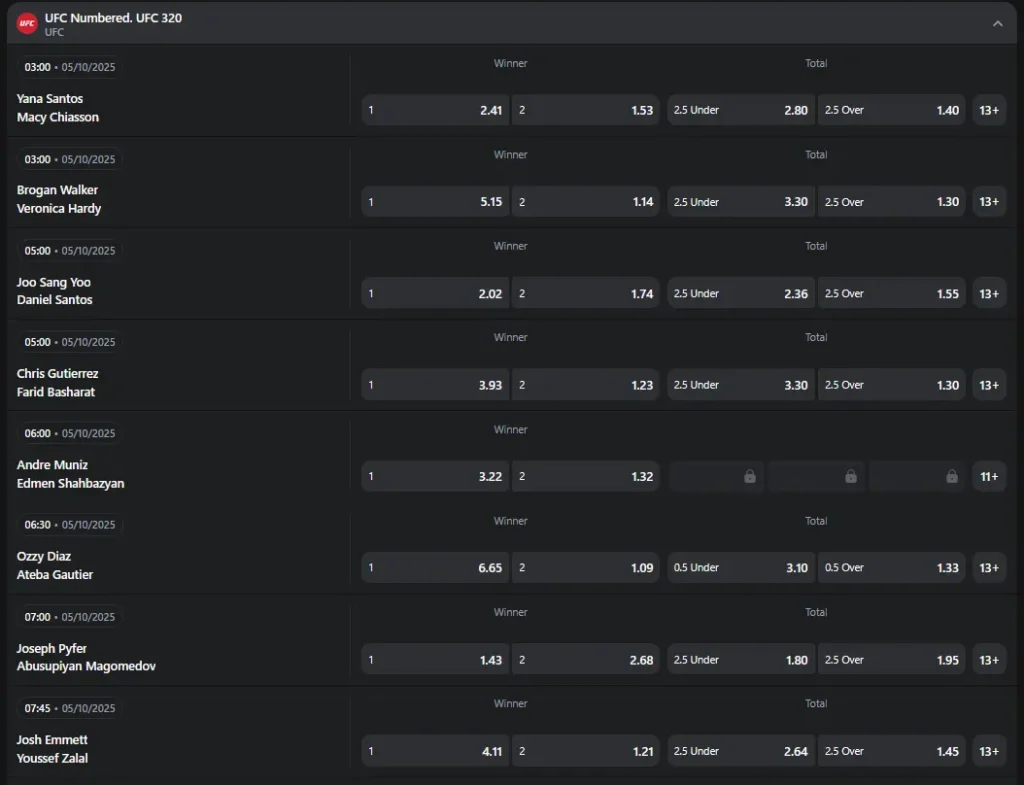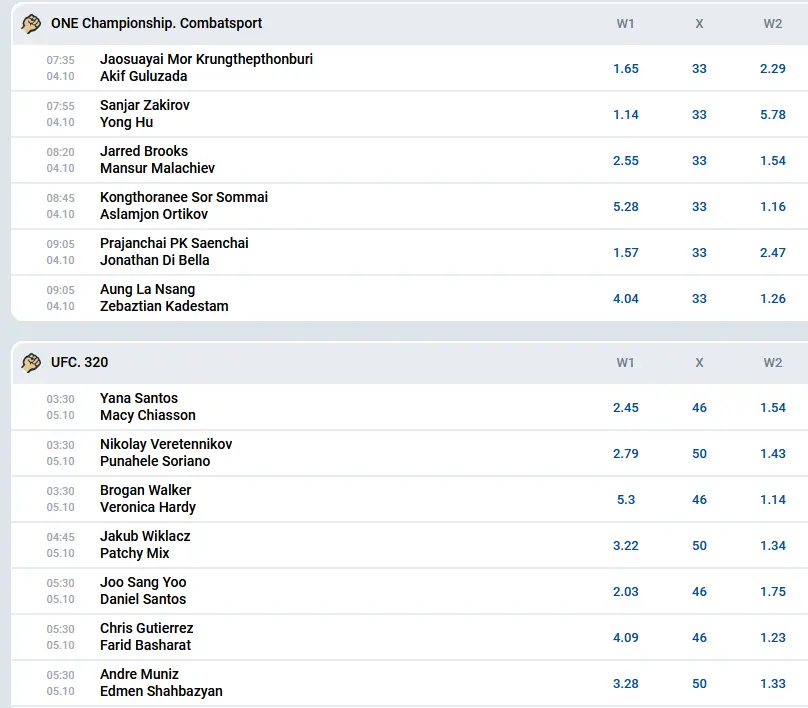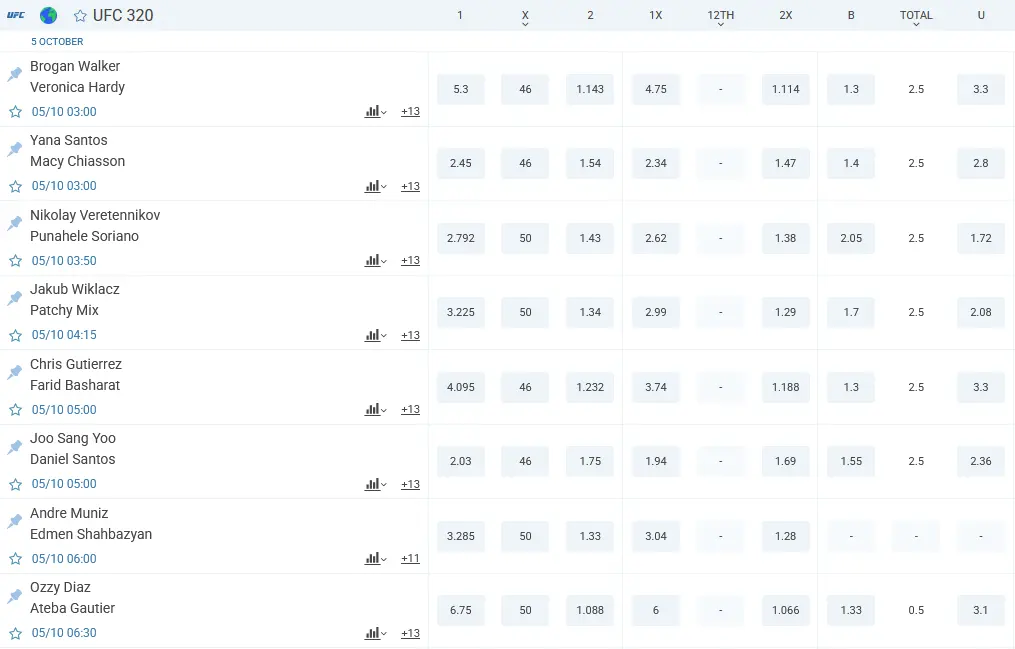MMA Wagering: Strategic Combat Analysis
MMA involves individual combat sports for analytical wagering, combining striking skills with grappling techniques and ground control. The sport’s scoring systems, performance metrics, and shifts in control create opportunities for analysts who understand fighter psychology, technical execution, and strategic adaptation through different phases of fights.
Fundamentals of MMA Analysis
Professional MMA analysis requires understanding the interaction between physical attributes, technical skills, and mental preparation that determines competitive outcomes. Unlike team sports, MMA reduces external variables while focusing on individual performance factors that influence fight results.

MMA
Physical condition assessment forms the basis of MMA analysis as endurance, strength, and recovery capability determine performance across rounds. Fighters in physical condition show punch output, grappling efficiency, and effectiveness in later rounds.
Technical skill evaluation includes striking accuracy, grappling control, submission attempts, and tactical adaptation that distinguish fighters. Understanding technical proficiency helps predict performance against different opponent styles and strategic approaches.
Fighting style compatibility leads to matchup dynamics as certain combinations favor one competitor over another based on skills. Strikers may face challenges against wrestlers, while grapplers could encounter issues with stand-up specialists.
Training camp analysis shows preparation quality through sparring partner choices, conditioning work, and tactical focus that affects fight performance. Prepared fighters demonstrate conditioning and strategic execution compared to those with limited preparation.
Age and experience affect performance as fighters improve in their twenties and may decline later, though patterns vary based on style and career handling.
Career management evaluation looks at opponent selection, training intensity, and balance between activity and recovery that influence performance consistency.
Popular MMA Betting Markets
Match
Mostbet
1xBet
1Win
Fighter 1
Fighter 2
Fighter 1
Fighter 2
Fighter 1
Fighter 2
Sakrit Superlek Muaythai vs Logan Chan
2.05
1.72
2.05
1.72
2.05
1.72
Juliana Otalora vs Kim Tran
2.65
1.45
2.659
1.45
2.66
1.45
Kyung Joong Kim vs Su Sung Cho Gotoh
2.48
1.51
2.481
1.51
2.48
1.51
Rayan Mekki vs Muga Seto
2.73
1.43
2.728
1.43
2.73
1.43
Liu Yuer vs Nefise Delikurt
2.16
1.66
2.166
1.66
2.17
1.66
Fighter Victory Methods
MMA provides victory prediction options that involve understanding path scenarios and probability based on fighter traits and dynamics.
Knockout betting assesses fighters’ striking power and defensive skills as outcomes depend on offensive force and vulnerabilities.
Submission victory predictions analyze grappling skills and ground control as finishes occur through technique and position.
Decision victory markets look at fighters’ ability to win rounds without finishes through control and scoring.
Round Betting Analysis
Round-specific predictions use fight flow analysis and understanding of phase development based on styles and strategies.
Early round finish analysis focuses on aggressive fighters against vulnerable opponents where quick ends are possible.
Late round markets suit analysts who understand conditioning differences and stamina effects in later rounds.
Total Rounds Markets
Fight duration betting analyzes factors influencing length including durability, power, and approaches that affect finish probability.
Over/under round totals reflect expected competitiveness as matched opponents produce longer fights while disparities lead to shorter ones.
Scorecards and Decision Analysis
MMA judging creates wagering opportunities through scoring criteria and judge views that influence decisions.
Unanimous decision betting involves fights where one fighter shows superiority across categories in rounds.
Split decision markets apply when fights have close battles where judging could favor either side.

MMA Betting
Weight Division Characteristics
UFC Fight Night
Bellator Champions Series
PFL World Championship
ONE Championship
UFC Pay-Per-View
RIZIN Fighting Federation
KSW Epic
Invicta FC
Dana White's Contender Series
Cage Warriors
LFA Legacy Fighting Alliance
Brave Combat Federation
ONE Fight Night
Bellator Grand Prix
PFL Playoffs
UFC on ESPN
Heavyweight Division
Heavyweight MMA includes outcomes due to power that can change fights in exchanges. The lack of weight cutting creates physical dynamics different from smaller divisions.
Power analysis matters as heavyweight fighters have capability to end fights, making defensive errors costly.
Conditioning requirements vary from smaller divisions as heavyweights engage in paced battles that test fitness preparation.
Experience provides advantages as heavyweight fighters compete into their thirties when knowledge compensates for physical changes.
Light Heavyweight Through Middleweight
Middle divisions combine power, speed, and endurance that create competitive environments in MMA.
Athletic analysis identifies fighters in performance periods as middle-division competitors show physical capabilities during career phases.
Style diversity exists in middle divisions as tactical approaches remain viable without extreme physical factors.
Welterweight Through Lightweight
Lower weight divisions focus on speed, technical precision, and tactical execution while keeping power for finish opportunities.
Conditioning advantages appear as lighter fighters maintain work rates across fights requiring cardiovascular preparation.
Technical skill differences decide outcomes as reduced power means fights depend on tactical advantages rather than single moments.
Featherweight and Below
Smaller divisions include technical skill levels and pace throughout fights while lowering finish probability to focus on tactical fighting.
Volume capability determines success as lower-weight fighters win through activity rather than isolated power actions.

MMA 1Win
MMA Match Analysis Categories
Style Matchup Evaluation
Understanding how fighting styles interact forms the basis for MMA analysis as combinations produce competitive dynamics.
Strikers who focus on stand-up typically face issues against grapplers who use takedowns and ground control to limit striking opportunities.
Grapplers relying on wrestling and submissions often have difficulties against mobile strikers who maintain distance and avoid ground positions.
Versatile fighters depending on mixed skills may struggle against specialists who force fights into specific areas.
Southpaw analysis involves understanding how left-handed fighters create advantages against orthodox opponents through stance and angle use.
Physical Attribute Assessment
Physical advantages determine outcomes when skill levels are equal, making attribute analysis necessary for fight prediction.
Reach advantages offer benefits through striking distance and defensive spacing that control pace and range.
Height differentials affect approaches as taller fighters use outside fighting while shorter opponents seek close positions to reduce reach effects.
Power differential analysis predicts finish probability and approach as fighters with power advantages pursue aggressive strategies while opponents focus on defense and point building.
Speed advantages appear in forms like hand speed, foot movement, and reaction time that affect offensive and defensive actions.
Preparation Quality Analysis
Training camp evaluation shows fighter preparation through conditioning, sparring, and tactical adjustments that indicate readiness and focus.
Sparring partner selection indicates camp quality as fighters using partners who match opponent styles show tactical preparation.
Conditioning assessment examines cardiovascular fitness, strength, and weight management that impact performance across fights.
Injury management in preparation affects performance as injuries can appear during fights through reduced activity or changed patterns.

MMA Mostbet
Advanced MMA Analysis Techniques
Statistical Performance Modeling
MMA analysis uses statistical evaluation that measures performance aspects across scenarios.
Strike statistics including output, accuracy, and impact provide measures of offensive effectiveness linked to success.
Grappling metrics include takedown success, control time, and submission attempts that show control and tactical skill.
Activity consistency shows stamina and discipline as fighters with steady output demonstrate conditioning preparation.
Psychological Factor Assessment
Mental aspects matter in combat sports as confidence, motivation, and pressure handling affect physical and tactical performance.
Confidence evaluation looks at recent trends and circumstances that affect state entering fights.
Pressure response analysis shows how fighters handle stress like crowd, title, and adversity that impact performance.
Motivation assessment considers incentives, career factors, and circumstances that influence training and fight effort.
Career Trajectory Analysis
Understanding career arcs helps predict trends and identify opportunities in markets.
Prime identification recognizes fighters in performance periods when attributes align with experience for competitive effectiveness.
Decline recognition shows when fighters experience reduced capabilities that create opportunities against improving opponents.

MMA 1xBet
Weight Class Specific Strategies
Heavyweight Analysis Focus
Heavyweight MMA needs analytical approaches accounting for division traits like power, conditioning, and experience.
Finish power assessment is critical as heavyweight fighters maintain ending capability across fights.
Conditioning evaluation focuses on fitness aspects as heavyweight fights feature pace but demands per action.
Middle Division Assessment
Welterweight through light heavyweight divisions combine athletic factors that create competitive environments.
Athletic balance analysis examines how fighters combine speed, power, and endurance for division success.
Technical skill evaluation is crucial as middle divisions have depth where tactical advantages determine outcomes.
Lower Weight Analysis
Featherweight and below emphasize precision and activity while reducing variables that dominate heavier divisions.
Volume analysis is key as lower-weight success depends on output rather than isolated actions.
Technical precision evaluation focuses on accuracy and positioning that determine success with minimal power differences.



 Kieran Aldridge
Kieran Aldridge
